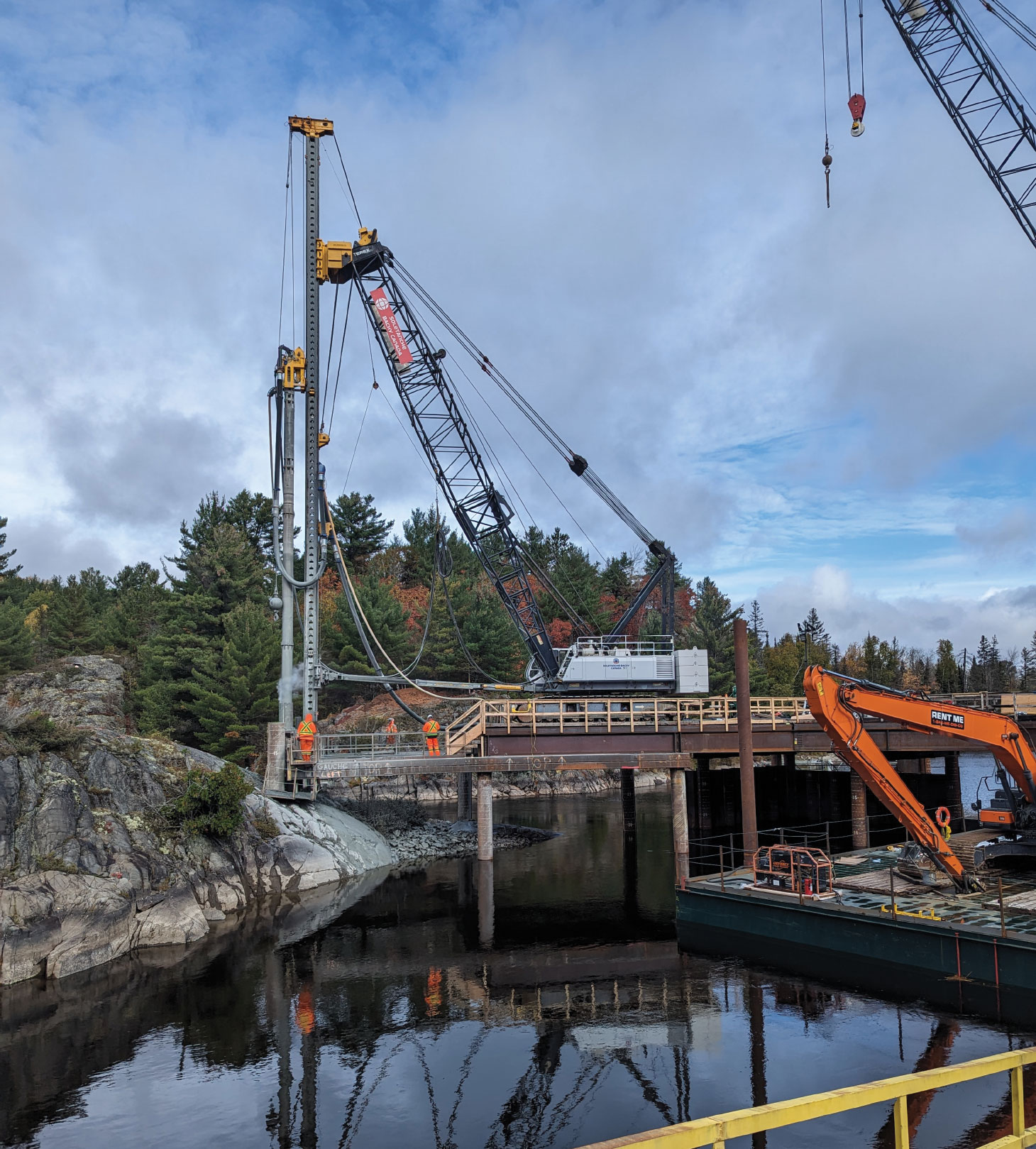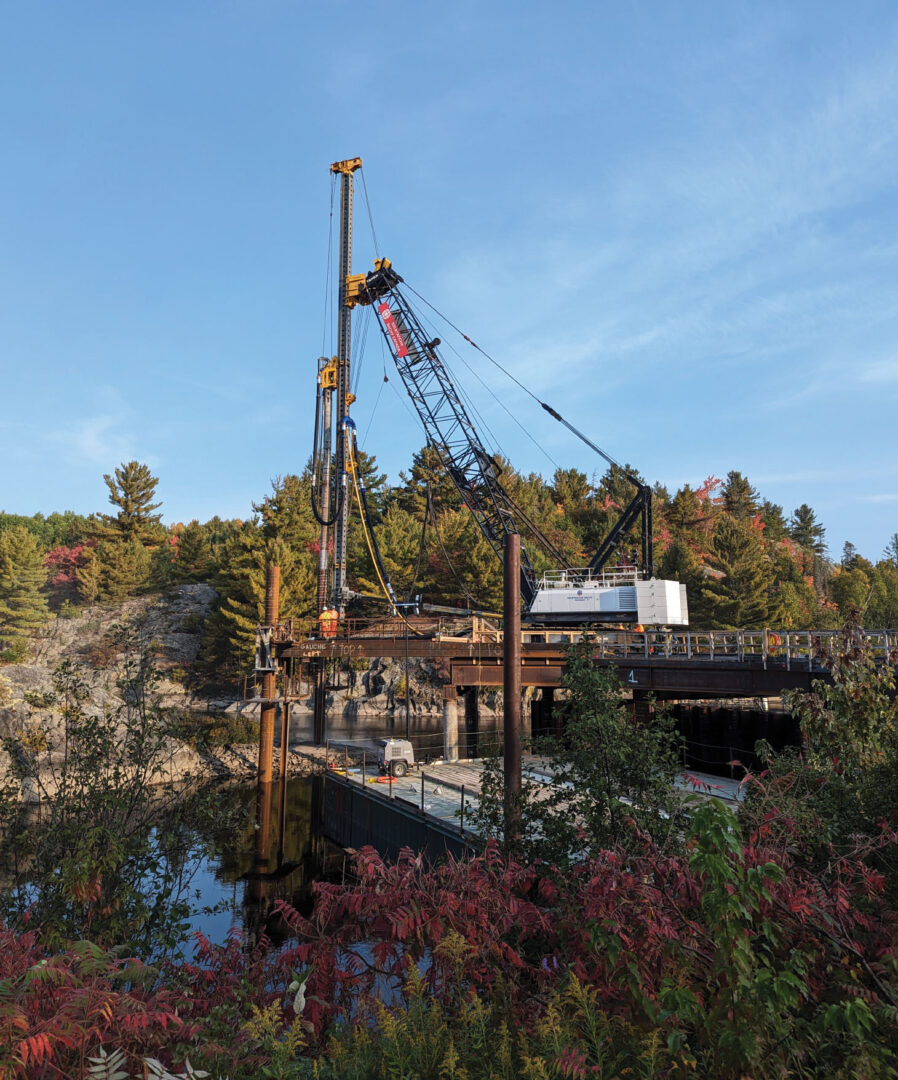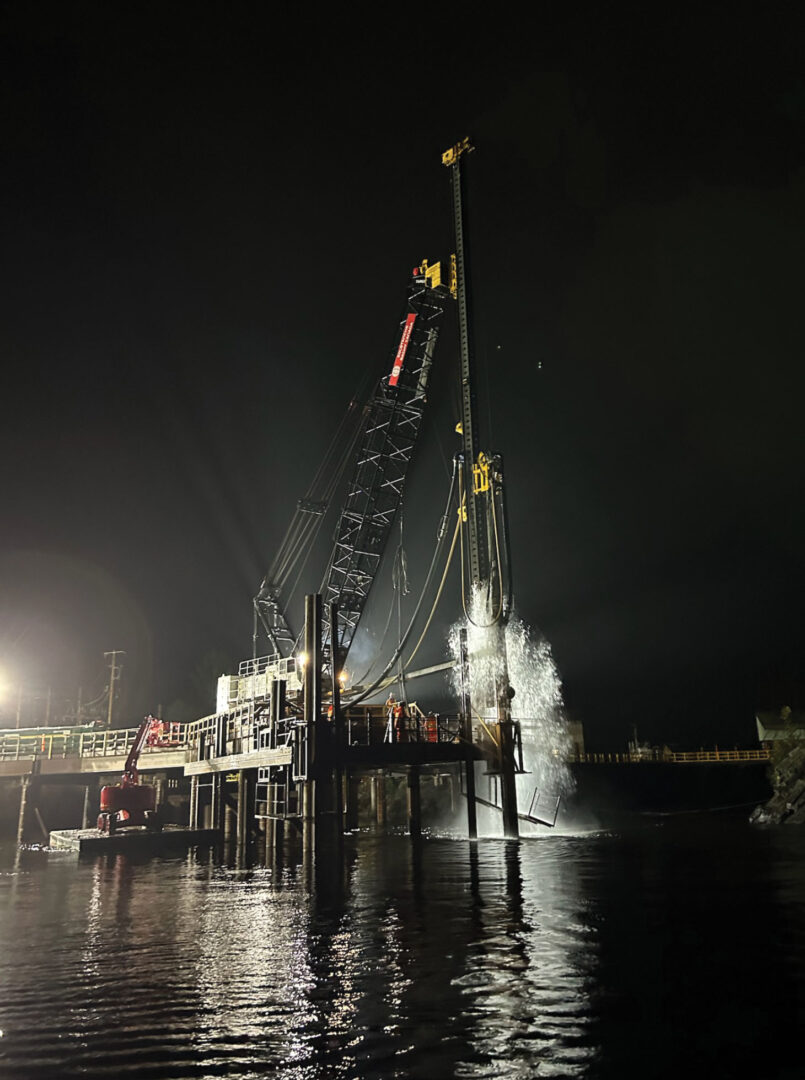
Located on the Spanish River in the heart of northern Ontario, the Nairn Falls Generating Station has been providing power to the surrounding area for more than a century. The spillway was first commissioned in 1915 and its hydroelectric generating station supplies 4.5 milliwatts of power to mining operations around Sudbury, as well as to Ontario’s power grid.
However, the venerable power plant is now beginning to show its age and, after many years of service, has finally reached the end of its useful service life. Due to this, the decision was made to design and construct a new and upgraded power generating station and spillway at the site, which will allow for more efficient power generation into the foreseeable future.
When complete, the new generating station will feature a four-bay concrete spillway equipped with vertical lift gates on the same footprint as the existing spillway, as well as powerline relocations, a new access road and retaining walls on the island located between the spillway and the shoreline. As part of the project, there are also several temporary works, including upstream and downstream cofferdams, training walls, a dewatering system, crane pads and a temporary bridge.
Work on the project began in May 2022, with the construction phases being separated to allow for better water management through the station, including passing the flow of freshet – or snow melt – to help mitigate the risk of upstream inundation and to pass water downstream into spawning habitats.
With more than 180 years of collective experience providing innovative geotechnical solutions across North America, Soletanche Bachy Canada (SB Canada) was selected to facilitate the replacement of the generating station by constructing an upstream cofferdam and trestle.
Shaped like a “Y,” the trestle and cofferdam create a fork for multiple paths of travel and access to the work area, as well as helps divert water from the existing spillway and generating station. The cofferdam operates as a fully functional dam with working gates, which means SB Canada can control the flow of water during construction. The trestle allows for construction access to the opposite side of the river feeding the spillway and generating station.
A challenging project
The power generating station and spillway have been active for many decades and have reached the end of their service life. Therefore, the construction schedule is critical to the ultimate success of the project.
“There is an urgency to create adequate access and successfully divert water from the existing structure to help facilitate replacement, and SB Canada has implemented a 24-7 working schedule to help achieve the desired completion date,” said Paul Dlugosz, SB Canada’s project manager.
One of the project’s most significant technical challenges is related to construction tolerances and the significant variation in the rock profile. SB Canada overcame these issues by choosing the correct methodologies for the job quickly and effectively. The company also mobilized the project site within a month of being awarded the contract to maximize the project schedule by beginning the construction phase as soon as possible, while also continuing preparatory efforts for future operations.
Working adjacent to an active spillway has also presented significant challenges because of the fast flow of water – in excess of 5,000 cubic feet per second – through the construction area. The methodologies selected for construction have helped limit SB Canada’s exposure to the extremely fast currents and have allowed construction to take place from the previously installed trestle sections, as well as from a variety of barge arrangements.

The tools for the job
The piling scope of the project has included the installation of 24-inch pipe piles with 10-foot rock sockets to support a trestle bridge and to facilitate the construction of the temporary cofferdam and trestle. The project also needed the installation of tie-down anchors to reinforce the cofferdam in its dewatered state and the installation of a diversion structure with rock anchor reinforcement on the side of a significant rock outcrop adjacent to an active spillway.
There were also significant slopes in the existing bedrock profile that made it more difficult to install some of the piling and deep foundation components. Vibration considerations were also needed while completing the work next to the existing concrete structures, since those structures are approximately a century old and there was the potential of structural damage occurring.
Working with Berminghammer Foundation Equipment, SB Canada went to great lengths to ensure the appropriate systems were selected for the foundation elements of the project based on the site conditions. This has permitted SB Canada to efficiently execute the work while adhering to the construction tolerances specified.
“Most of the time, the biggest challenge is determining methodology at the beginning of the project, which involves reviewing the job details and picking a methodology that optimizes the available rental leads, tooling and cranes,” said David Zanchetta, P.Eng., Berminghammer’s sales representative.
For this project, SB Canada is using a reverse circulation Berminghammer BRC35 rotary and down-the-hole (DTH) hammer system. The system is equipped on a 90-foot L23 vertical travel lead system mounted on a Terex HC165 crane, which is installing the pipe piles (equipped with Robit driving shoes) through an engineered template system that is secured to the previously constructed trestle section.
DTH drilling allows for rapid advancement of the pile into the rock compared to conventional soil drilling methods. Where conventional drilling in hard rock can take hours per inch, DTH drilling methods allow crews to advance metres in minutes. What’s more, when reverse circulation drilling is added to the mix, it allows any spoils to be directed to appropriate disposal areas, minimizing the impact to the nearby marine ecological area.
“Much like a hand drill does with a percussive setting, where the drill bit bounces up and down on the surface it is drilling to break it apart, the DTH hammer operates with air to lift and rapidly drop a weight inside the hammer,” said Zanchetta. “What is clever with reverse circulation drilling, however, is that the rock cuttings can be collected and discharged down along a long tube to wherever you want to put them, controlling the cuttings that would otherwise be flying everywhere. This control allows you to protect environmentally sensitive areas and, in this regard, the DTH system with reverse circulation can be the best tool in your arsenal.”

Protecting the environment
There have been multiple environmental considerations taken during the construction of the project to protect the quality of the water and to mitigate the effect of the project on wildlife in the area.
The water levels and flow regimes were closely managed to avoid permanent overprinting, and temporary footprints were shifted away from the spawning habitats of fish in Spanish River and to avoid impacting lake sturgeon populations. This meant avoiding in-water work during sensitive time windows and establishing pass flows through both channels during the spring spawning season.
“We developed a site-specific environmental plan to ensure the appropriate measures are being taken, along with rigorous controls, to ensure that there are no adverse effects on the environment,” said Dlugosz. “The implemented controls are being consistently monitored with added measures in place for higher risk activities.”
SB Canada also equips their equipment with environmentally friendly hydraulic fluids, combined with anti-idling policies, to limit the environmental impact of their projects wherever possible.
Much of the success of the project to date is a result of establishing the lines of communication early and a commitment to collaboration with the client. SB Canada maintains a program to help identify corrections made in the field prior to completing work or an event occurring, which helps encourage open dialogue and information sharing as it provides an opportunity to learn about potential improvements or issues, and to prevent potential events from occurring in the future. The client’s response to the project has been nothing short of positive due to these measures.
“The client is appreciative of the proactive safety culture we have at SB Canada, as well as our adaptiveness to any changes and challenges encountered on the project so far,” said Dlugosz. “Our ability to react and quickly implement and act on suitable solutions has [greatly benefited] the project, and allowed us to execute the work safely and efficiently.”
The new spillway and generating station on Nairn Falls are expected to be up and running later this year.